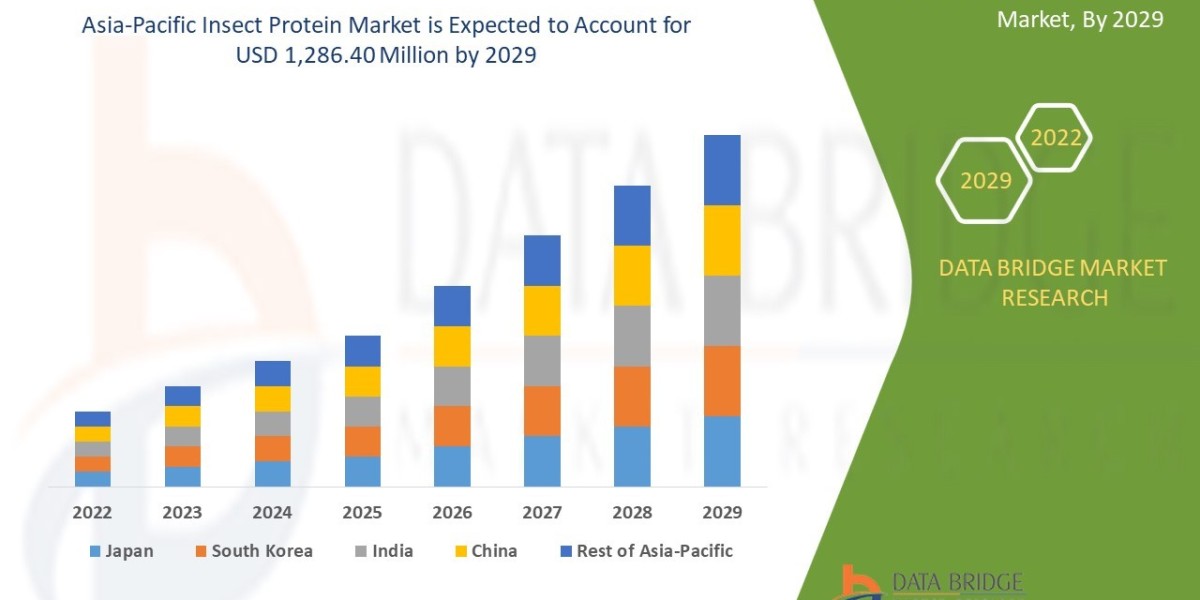Introduction
The Asia-Pacific insect protein market is rapidly emerging as one of the most dynamic sectors in the global alternative protein landscape. Insect protein, derived from sources such as crickets, mealworms, black soldier fly larvae, and grasshoppers, is increasingly recognized for its high nutritional value, sustainable production methods, and versatile applications across food, feed, and industrial sectors. As the global population continues to grow and conventional protein sources face environmental and resource limitations, insect protein is positioning itself as a critical solution for future food security.
Asia-Pacific, with its long cultural history of entomophagy (the practice of eating insects), offers fertile ground for the insect protein industry to flourish. Countries such as Thailand, China, Vietnam, and Japan are already familiar with insect-based foods, while newer markets in Australia, South Korea, and India are beginning to embrace insect protein as part of a broader shift toward sustainable and alternative proteins.
This report provides a comprehensive analysis of the Asia-Pacific insect protein market, covering its current landscape, drivers, challenges, segmentation, competitive strategies, and future opportunities. The scope includes both food and non-food applications, offering insights for investors, producers, and policymakers.
Source - https://www.databridgemarketresearch.com/reports/asia-pacific-insect-protein-market
Market Overview
The Asia-Pacific insect protein market encompasses the farming, processing, and commercialization of insect-derived proteins for use in human food, animal feed, aquaculture, and specialty applications. Insects are highly efficient protein sources, boasting high feed conversion ratios, minimal land and water requirements, and lower greenhouse gas emissions compared to livestock. This makes them an attractive option for addressing sustainability challenges associated with traditional protein production.
Historically, insect consumption has been embedded in local diets in many parts of Asia, particularly in Southeast Asia. Over the past decade, however, the industry has shifted from small-scale traditional practices to commercial-scale production facilities. This evolution has been driven by rising demand for sustainable proteins, advancements in insect farming technologies, and growing acceptance of alternative proteins among consumers.
The current landscape of the Asia-Pacific market reflects strong growth potential. Human food applications, including protein powders, snacks, and bakery products, are expanding rapidly, while insect protein for aquafeed and livestock feed has gained attention as a cost-effective and environmentally friendly substitute for fishmeal and soybean meal. Although exact growth figures vary by source, the region is widely projected to be one of the fastest-growing markets for insect protein worldwide.
Market Drivers and Opportunities
Several factors are propelling the growth of the insect protein market in Asia-Pacific.
The primary driver is sustainability. With the livestock industry facing criticism for its environmental footprint, insect protein offers a more resource-efficient solution. Insects can be farmed on organic waste and require significantly less land and water than traditional livestock, aligning with the region’s sustainability goals.
Nutritional benefits also fuel demand. Insect protein is rich in essential amino acids, vitamins, minerals, and healthy fats, making it a competitive alternative to traditional protein sources. This nutritional profile appeals to health-conscious consumers, particularly in urban areas where demand for protein-rich diets is on the rise.
The food and beverage industry presents significant opportunities. Insect-based snacks, protein bars, and powders are gaining traction as functional foods and sports nutrition products. Similarly, the feed industry offers vast potential, especially in aquaculture-heavy markets like China, Vietnam, and Indonesia, where insect protein can serve as a sustainable replacement for fishmeal.
Technological advancements, such as automated insect farming systems, precision breeding, and innovative processing methods, further expand market opportunities. Investors and entrepreneurs are entering the space, attracted by the scalability and diverse applications of insect protein. As regulatory frameworks in the region mature, opportunities for commercialization will only grow stronger.
Market Challenges and Restraints
Despite its promising outlook, the insect protein market in Asia-Pacific faces several challenges.
Consumer acceptance remains a critical hurdle, particularly in regions where insect consumption is not traditionally practiced. While Southeast Asia has a cultural affinity for entomophagy, markets such as Australia and India may take longer to normalize insect protein as a mainstream food ingredient. Overcoming the “yuck” factor requires sustained education, marketing, and product innovation.
Regulatory frameworks are another challenge. While some countries have taken steps to regulate insect protein production and consumption, many markets lack standardized policies. This creates uncertainty for producers and investors, slowing down industry expansion.
Supply chain and scalability issues also pose risks. Insect farming is still in its early stages, with limited infrastructure and relatively high production costs compared to traditional feed and protein sources. Ensuring consistent quality, safety, and large-scale production capacity remains a pressing concern.
Competition from alternative proteins, such as plant-based and cultured meat, could also limit market share. These sectors are already well-funded and enjoy significant consumer visibility, requiring the insect protein industry to differentiate itself through cost, sustainability, and nutritional benefits.
Market Segmentation Analysis
The Asia-Pacific insect protein market can be segmented by product type, application, distribution channel, and region.
By product type, cricket protein dominates the food and beverage segment due to its mild flavor, versatility, and established consumer familiarity. Black soldier fly protein leads the feed segment, particularly for aquaculture and poultry, due to its high protein content and efficient production systems. Mealworms and grasshoppers also hold growing potential in both food and feed applications.
By application, the market is divided into human food, animal feed, aquafeed, and specialty products such as pet food and cosmetics. Human food is gaining visibility in urban markets, with insect protein incorporated into snacks, powders, and bakery items. Feed applications, however, remain the largest and fastest-growing segment, driven by the need for sustainable and affordable protein in livestock and aquaculture.
Distribution channels include supermarkets, specialty health food stores, online platforms, and business-to-business (B2B) sales for feed manufacturers. E-commerce platforms are particularly important for niche food products, enabling startups to reach health-conscious and adventurous consumers directly.
Regionally, Southeast Asia leads the market, supported by cultural acceptance and growing commercialization. China is a key player, both as a consumer and producer, while Japan and South Korea represent innovation-driven markets with high potential for premium insect-based products. Australia and India are emerging markets, where consumer education and regulatory development will play critical roles in shaping future demand.
Competitive Landscape
The competitive landscape of the Asia-Pacific insect protein market includes a mix of startups, established agribusinesses, and research-driven enterprises. Leading companies are focusing on scaling up production, improving efficiency, and diversifying applications to strengthen their market position.
Recent years have seen increased investments in automated insect farming systems, particularly in black soldier fly larvae production for feed applications. Partnerships between insect protein companies and feed producers are common, as both sectors work to create sustainable supply chains for aquaculture and livestock industries.
Innovation is another competitive strategy. Food companies are launching insect-based protein bars, snacks, and powders targeted at urban consumers and athletes. Branding efforts emphasize sustainability, nutrition, and novelty to overcome consumer hesitation.
Mergers, acquisitions, and cross-border collaborations are also shaping the market, as players seek to expand geographic reach and secure technological advantages. Companies that prioritize transparency, food safety, and traceability are better positioned to gain consumer trust and regulatory approval.
Future Outlook and Trends
The future of the Asia-Pacific insect protein market is bright, with strong growth expected over the next five to ten years. Rising environmental concerns, growing protein demand, and technological innovation will remain the primary drivers.
One of the most significant trends will be the mainstreaming of insect protein in functional foods and dietary supplements. As health-conscious consumers look for sustainable and nutrient-rich options, insect protein powders and fortified foods are likely to gain popularity.
In the feed industry, insect protein is set to play a transformative role. Aquaculture and poultry sectors, in particular, will increasingly turn to insect protein as a sustainable and cost-effective substitute for fishmeal and soy. This shift will help alleviate pressure on overfished oceans and reduce the environmental impact of traditional feed ingredients.
Sustainability and circular economy practices will dominate the industry’s future, with insect farming leveraging food waste streams to create high-value proteins. Blockchain and digital traceability tools may also emerge, enhancing consumer confidence and supply chain transparency.
Regionally, Southeast Asia will continue to lead due to cultural acceptance and established infrastructure, while China, Japan, and South Korea will drive innovation and consumer-focused product development. Australia and India will gradually catch up, supported by regulatory progress and growing awareness of sustainable protein alternatives.
Conclusion
The Asia-Pacific insect protein market is at the forefront of the alternative protein revolution, offering sustainable, nutritious, and versatile solutions for both food and feed industries. While challenges such as consumer acceptance, regulatory gaps, and scalability remain, the market’s long-term growth prospects are undeniable.
Driven by sustainability imperatives, technological advancements, and evolving consumer preferences, insect protein is poised to play a significant role in addressing food security and environmental challenges in the region. For businesses and investors, this market represents a unique opportunity to participate in shaping the future of protein consumption and sustainable agriculture in Asia-Pacific.
Frequently Asked Questions
What is the current size of the Asia-Pacific insect protein market?
The market is expanding steadily, driven by rising demand for sustainable protein sources. While exact numbers vary by research, Asia-Pacific is considered one of the fastest-growing regions globally for insect protein adoption.
What are the key drivers influencing growth in this market?
Sustainability, high nutritional value, growing demand for alternative proteins, and the rising need for affordable livestock and aquaculture feed are the primary growth drivers.
Which regions dominate the Asia-Pacific insect protein market?
Southeast Asia leads due to cultural acceptance and established consumption, while China is both a producer and consumer. Japan, South Korea, Australia, and India are emerging as important growth markets.
Who are the major players in the industry?
The market consists of startups, established agribusinesses, and research-driven companies focusing on insect farming and processing. Many are innovating in food products, feed applications, and automated farming systems.
What are the latest trends shaping the future of this market?
Key trends include the rise of insect-based functional foods, expansion of insect protein in aquafeed, adoption of circular economy practices, and increased investment in automation and biotechnology.
What challenges could slow down growth in this sector?
Consumer reluctance, lack of standardized regulations, high production costs, and competition from other alternative proteins could slow adoption.
How can businesses benefit from investing in the insect protein market?
Businesses can benefit by tapping into both food and feed markets, offering sustainable solutions, leveraging technological innovation, and targeting health-conscious and eco-aware consumers.
Browse More Reports:
Global Urticaria Market
Global UV Adhesive Market
Global Varicose Vein Treatment Market
Global Veneer Sheets Market
Global Windows and Doors Market
Europe Alcoholic Beverages Market
Asia-Pacific Alopecia Treatment (Hair Loss) Market
Middle East and Africa Alopecia Treatment (Hair Loss) Market
Thailand Business Process Outsourcing (BPO) Market
Europe Corrugated Board Packaging Market
Asia-Pacific Essential Oils Market
U.S. Fleet Management Market
North America Fleet Management Market
Middle East and Africa Helium-3 Market
Europe Hemodialysis and Peritoneal Dialysis Market
Europe Industrial Metrology Market
Middle East and Africa Industrial Metrology Market
Europe Insect Protein Market
Asia-Pacific Insect Protein Market
Middle East and Africa Insect Protein Market
About Data Bridge Market Research:
An absolute way to forecast what the future holds is to comprehend the trend today!
Data Bridge Market Research set forth itself as an unconventional and neoteric market research and consulting firm with an unparalleled level of resilience and integrated approaches. We are determined to unearth the best market opportunities and foster efficient information for your business to thrive in the market. Data Bridge endeavors to provide appropriate solutions to the complex business challenges and initiates an effortless decision-making process. Data Bridge is an aftermath of sheer wisdom and experience which was formulated and framed in the year 2015 in Pune.
Contact Us:
Data Bridge Market Research
US: +1 614 591 3140
UK: +44 845 154 9652
APAC : +653 1251 975
Email:- corporatesales@databridgemarketresearch.com







